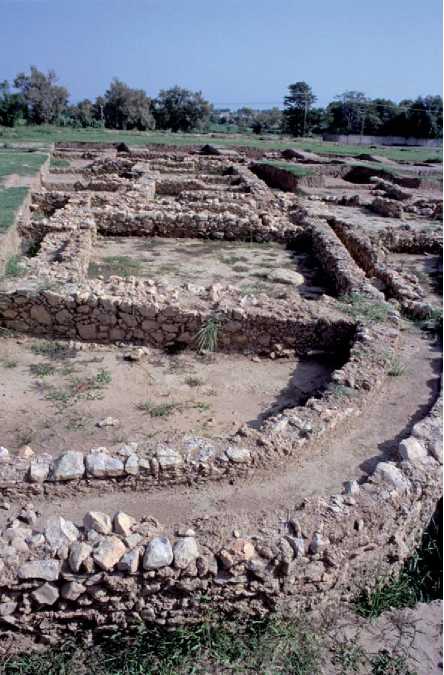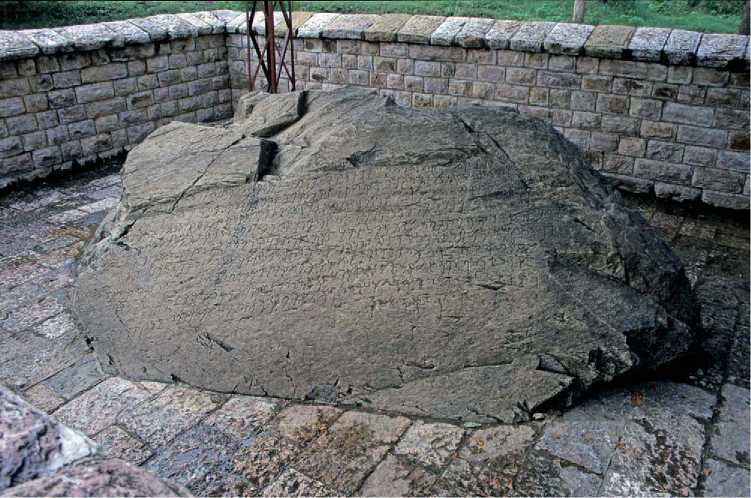This phase of increased complexity resulted in the emergence of nascent polities in the Northwest, centered on Taxila and Charsadda but augmented by the dramatic growth of the settlement of Akra in Bannu to the south. However, their success was not unnoticed and led to its dramatic annexation by Darius the Great in 520 BC. Renamed the satrapy of Gandhara, the newly partitioned region saw the imposition of Achaemenid garrisons, coinage, and script. Now part of a political and economic identity stretching from the Aegean to the Indus, annual tribute and levies of conscripts were drained, as illustrated on the bas-reliefs of Persepolis.
In contrast with the textual evidence, archaeological evidence of Achaemenid occupation is limited even in the regional capitals of Charsadda and Taxila, although Achaemenid levels have been postulated at Balambat in the Dir Valley. Suggesting that the new satrapy enjoyed a high degree of autonomy, the ceramic and artifactual corpus of Taxila and Charsadda indicate that strong links with the Gangetic states were retained throughout this period. The same is true of the region’s later incorporation into the empire of Alexander the Great. The fact that, despite a century of searching, none of his newly founded cities has been identified suggests that Alexander was no more than a temporary interruption and it was left to his successors to spread Hellenistic art and architectural styles 200 years later.
The Mauryan Empire
As Alexander’s generals were fusing personal empires after his death, the Selucids readily ceded the Northwest Frontier to a relatively unknown raja from the Ganges in exchange for 500 war elephants. The raja, Chandragupta Maurya, used the exchange to confirm the ascendancy of his kingdom of Magadha and began the elimination of his competitors (see Asia, South: Ganges VaLley).

Figure 12 Curving drain and residential structures at the Bhir Mound, Taxila.
Whilst Greek and Achaemenid evidence is sparse, Mauryan occupation is readily available at the Bhir Mound in the Valley of Taxila. Capital of Gandhara, Taxila’s location at the bifurcation of the routes to Central and Western Asia was so important that its Viceroy was one of Chandragupta’s grandsons - Asoka. The Bhir Mound was an unfortified stone-built settlement of narrow streets covering an area of 1100 by 670 m. While there is evidence of limited civic control, it is only at the Dharmarajika stupa beyond the town that monumental investment is found in the construction of a 15 m wide Buddhist stupa (Figure 12).
Ashoka’s Edicts
The presence of a similar monument in the Swat Valley at Butkara indicates the impact of Mauryan influence into the valleys, as does the scatter of sites with access to Northern Black Polished Ware, such as Bir-kot-ghundai in the Swat Valley, the Bhir Mound, and Charsadda in the Vale of Peshawar. Finally, it is indicated by the presence of three Asokan rock edicts in the Northwest Frontier. The first at Sirkap in the Taxila Valley, the second at Manshera on the way to Kashmir and Central Asia, and the third at Shahbazghari on the route to Afghanistan and Western Asia. All are written in Aramaic, indicating the Mauryan Empire’s Achaemenid inheritance and its desire to unify its own disparate communities (Figure 13).

Figure 13 The Asokan rock edict at Shahbazghari in the Vale of Peshawar.
Although there are no edicts in Kashmir, it is recorded that the monk Majjhantika was tasked by Asoka and the third Buddhist Council to introduce Buddhism to both Gandhara and Kashmir, confirming the linked nature of the two. Although of less magnitude than the Northwest, evidence of a Mauryan horizon in Kashmir is becoming clearer with contemporary brick-built structures at Ranihat on the eastern bank of the Alakananda River and at Semthan. Similarly, the presence of North Black Polished Ware, elite Mauryan tableware, at Ranihat and Moradhwaj indicates the close links between the imperial center in the Ganges and its northern periphery.




 World History
World History









